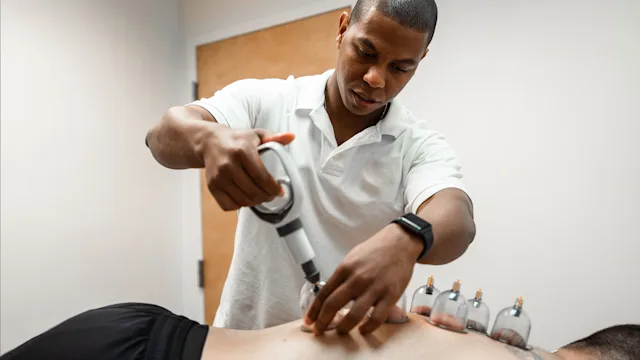Key takeaways:
Massage is a therapy for soft body tissues by trained professionals.
Research suggests that there are several benefits of massage therapy, from easing low back pain to relieving stress.
When added to standard medical care, various types of massage therapy help with overall health and well-being.
Massage therapy is more than a luxury. It's an ancient healing art that involves soft tissue manipulation by a licensed massage therapist (LMT). These trained professionals use movements to apply varying degrees of pressure to the body. And it may soothe aches and pains from various conditions.
In fact, several physical and mental health benefits of massage therapy could make it a valuable addition to your wellness routine. With so many massage styles, you can try different methods to find what works best for you.
Physical and mental health benefits of massage therapy
Massage therapy is a popular complementary health practice. People use it for everything from pain relief to general self-care. These top research-backed massage benefits suggest they might be on to something.
Search and compare options
1. Massage therapy may boost circulation
LMTs use different techniques to apply pressure to your soft tissues. That manual pressure may promote better blood flow throughout your body. A small study looked at the effects of a leg massage on healthy young adults. It significantly increased circulation in the massaged leg.
2. Massage therapy may release muscle tension
Hands-on massage therapy and greater circulation can loosen tight, stiff muscles. Different massage styles also combine movement and pressure. This may release tension or muscle knots and improve flexibility and range of motion in targeted areas.
3. Massage therapy may relieve joint and muscle pain
For many people, massage therapy is a go-to method to soothe muscle and joint pain. It's been shown to help relieve pain from various conditions, such as:
Fibromyalgia
Carpal tunnel syndrome
And it's been linked to less inflammation and better healing in muscle injuries. Just remember that massage therapy should never replace standard medical care. And for some, relief might be temporary.
Researchers tested the effects of complementary massage therapy in people with knee osteoarthritis. After eight weekly whole-body massage sessions, participants had less joint pain and stiffness and better physical function. Consistent massage after the 8-week mark helped maintain but did not enhance those benefits.
4. Massage therapy may soothe post-workout aches and pains
The pain-relieving properties of massage therapy aren't limited to specific health conditions. It may also lessen delayed-onset muscle soreness (DOMS) and promote flexibility after a workout. Less DOMS and better flexibility go a long way toward smoother exercise recovery.
Read more like this
Explore these related articles, suggested for readers like you.
5. Massage therapy may lower stress, anxiety, and depression
Stress relief probably tops the list of benefits for many massage therapy fans. And that's good news considering how many people report feeling stressed.
Massage may help you cope with everyday worries at work and in your personal life. And less stress could put you in a better mood. In one study, researchers found that a 10-minute massage lowered stress levels and increased relaxation. It may work by triggering the parasympathetic nervous system (PNS). The PNS helps calm your body after stressful situations.
When combined with standard medical care, massage therapy may also lessen symptoms of depression and anxiety. It's been shown to lower these symptoms in people with fibromyalgia, breast cancer, and chronic low back pain. But there's a need for more research on how it works.
Types of massage therapy and their respective benefits
Swedish massage therapy
Swedish massage is a slower-paced massage known for its physical and mental benefits. Research suggests that it promotes the feel-good hormones serotonin, oxytocin, and dopamine — in a similar way to exercise or meditation, for example. Swedish massage may also lessen cortisol, a stress hormone made by the adrenal glands.
This gentle therapy is highly effective for stress and anxiety, as well as for relaxation.
Thai massage therapy
Thai massage — also known as Thai yoga — takes place fully clothed on a padded floor, rather than on a massage table. A trained practitioner actively stretches you with practiced techniques known to relieve tension and boost flexibility.
This massage technique may improve flexibility and lower:
Pain
Anxiety
Muscle tension
Disability
Shiatsu massage therapy
Shiatsu — also known as finger pressure — is a Japanese style of massage. A practitioner moves in a rhythmic sequence from point-to-point on acupressure spots. These acupressure points refer back to specific organs in the body, similar to acupuncture.
Acupressure may help relieve nausea and vomiting, ease pain, and improve sleep quality.
Deep tissue massage therapy
This therapy uses firmer pressure to reach deeper layers of muscle and fascia. It can be helpful for chronic pain and tightness.
Deep tissue massage focuses on problem areas such as muscle knots or scar tissue. By releasing these areas, it can help ease pain and inflammation and improve range of motion. For example, deep tissue massage has been shown to help relieve chronic low back pain.
Prenatal massage therapy
It’s common to have musculoskeletal problems during pregnancy. As the baby grows, it places more stress on the low back and other joints. Prenatal massage offers safe, gentle pressure that can boost circulation and promote relaxation.
These aches and pains will go away over time. But massage may offer some relief throughout your pregnancy. Talk to your healthcare provider before your first prenatal massage. And look for recommendations on certified prenatal massage therapists.
Medical massage therapy
Medical massage aims to offer targeted symptom relief for certain diagnosed medical conditions. This treatment focuses on specific problem areas –– like the back or neck –– instead of the whole body.
Medical massage may be used as an adjunct treatment for conditions such as:
Cancer
Fibromyalgia
Chronic headache
Hot stone massage therapy
Hot stone massage is a hands-on therapy, in which a practitioner places smooth, heated stones on the body. These areas may include the:
Spine
Palms
Feet
Abdomen
Legs
Warm stones help soothe muscles and promote circulation. With the muscles more relaxed, a therapist can use lighter pressure to massage these areas.
More research is needed, but promising results suggest that it may be helpful for people living with kidney disease who are on dialysis.
Lymphatic drainage massage therapy
A specially trained therapist uses this technique to stimulate a person's lymphatic system. The lymphatic system is made of tissues and organs that help the body remove fluid and waste. Stimulating this system can improve circulation and limit swelling.
Therapists start in the center of the body, using a light touch, and move outward. Studies suggest this therapy can be helpful for those with lymphedema — a problem with fluid buildup in the body’s tissues.
Foot massage therapy
This massage style focuses on your feet to boost circulation and help with pain. But it’s not just your feet that benefit from this technique.
Studies suggest that it may help with:
Fatigue
Sleep
Pain
Depression
Anxiety
You can see a professional, or you can do it yourself with equally good results.
Precautions and side effects of massage
There are a few things to consider before scheduling a massage. First, talk to a healthcare provider. This is important if you have a chronic health condition or musculoskeletal injury. They can provide a professional recommendation for a trusted massage therapist.
Massage is generally considered a safe practice. But there have been rare reports of blood clots, nerve injuries, and bone fractures. You can look for massage therapists through the American Massage Therapy Association. This can help you verify that a massage therapist has been properly trained. And you can make sure that their license is up-to-date.
The bottom line
There are proven physical and mental health benefits of massage therapy. People use the therapeutic technique to relieve stress, soothe muscle aches, and help manage certain conditions. And there are numerous types of massage –– like Swedish, deep tissue, or hot stone –– to choose from. Each one has distinct benefits and therapy goals. So, it's important to find what works best for you.

Why trust our experts?



References
American Psychological Association. (n.d.). Stress in America 2022.
Baumgart, S. B. E., et al. (2020). Effect of psycho-regulatory massage therapy on pain and depression in women with chronic and/or somatoform back pain: A randomized controlled trial. Brain Sciences.
Centers for Disease Control and Prevention. (2023). Lymphedema.
Darabpour, S., et al. (2016). Effects of Swedish massage on the improvement of mood disorders in women with breast cancer undergoing radiotherapy. Iranian Red Crescent Medical Journal.
Davis, H. L., et al. (2021). Effect of sports massage on performance and recovery: a systematic review and meta-analysis. BMJ Open Sport & Exercise Medicine.
Dutfield, S., et al. (2022). The lymphatic system: Facts, functions & diseases. LiveScience.
Field, T. (2017). Massage therapy research review. Complementary Therapies in Clinical Practice.
Field, T., et al. (2005). Cortisol decreases and serotonin and dopamine increase following massage therapy. The International Journal of Neuroscience.
Field, T., et al. (2013). Rheumatoid arthritis in upper limbs benefits from moderate pressure massage therapy. Complementary Therapies in Clinical Practice.
Furlan, A. D., et al. (2015). Massage for low-back pain. The Cochrane Database of Systematic Reviews.
Ghavami, H., et al. (2019). Impact of hot stone massage therapy on sleep quality in patients on maintenance hemodialysis: A randomized controlled trial. Journal of Research in Medical Sciences.
Guo, J., et al. (2017). Massage alleviates delayed onset muscle soreness after strenuous exercise: A systematic review and meta-analysis. Frontiers in Physiology.
Harvard Health Publishing. (2014). Foot massage: The pause that refreshes and is good for you!
Institute for Quality and Efficiency in Health Care (IQWiG). (2019). Low back pain: Passive treatments: Massages, heat and manual therapy. InformedHealth.org.
Keeratitanont, K., et al. (2015). The efficacy of traditional Thai massage for the treatment of chronic pain: A systematic review. Complementary Therapies in Clinical Practice.
Koren, Y., et al. (2018). Deep tissue massage: What are we talking about? Journal of Bodywork and Movement Therapies.
Lee, J., et al. (2011). Effects of foot reflexology on fatigue, sleep and pain: A systematic review and meta-analysis. Journal of Korean Academy of Nursing.
Li, Y., et al. (2014). Massage therapy for fibromyalgia: A systematic review and meta-analysis of randomized controlled trials. PLos One.
Lopera, C., et al. (2017). Investigating the short-term effects of manual lymphatic drainage and compression garment therapies on lymphatic function using near-infrared imaging. Lymphatic Research and Biology.
Majchrzycki, M., et al. (2014). Deep tissue massage and nonsteroidal anti-inflammatory drugs for low back pain: A prospective randomized trial. The Scientific World Journal.
Mehta, P., et al. (2017). Contemporary acupressure therapy: Adroit cure for painless recovery of therapeutic ailments. Journal of Traditional and Complementary Medicine.
Meier, M., et al. (2020). Standardized massage interventions as protocols for the induction of psychophysiological relaxation in the laboratory: A block randomized, controlled trial. Scientific Reports.
Morhenn, V., et al. (2012). Massage increases oxytocin and reduces adrenocorticotropin hormone in humans. Alternative Therapies in Health and Medicine.
National Center for Complementary and Integrative Health. (2018). Massage therapy for health: What the science says.
National Center for Complementary and Integrative Health. (2019). Massage therapy: What you need to know.
National Holistic Institute A College of Massage Therapy (n.d.). Massage therapy profession stats.
Nazari, F., et al. (2015). The effect of massage therapy on occupational stress of Intensive Care Unit nurses. Iranian Journal of Nursing and Midwifery Research.
Perlman, A., et al. (2018). Efficacy and safety of massage for osteoarthritis of the knee: A randomized clinical trial. Journal of General Internal Medicine.
Radziejowski, P. (2018). Hot stone massage therapy – Mechanisms of the influence on the human organism of selected methods of use. Journal of Education, Health and Sport.
Rapaport, M. H., et al. (2018). Massage therapy for psychiatric disorders. Focus.
Robinson, N., et al. (2011). The evidence for Shiatsu: A systematic review of Shiatsu and acupressure. BMC Complementary Medicine and Therapies.
Rodrigues, L. M., et al. (2020). Lower limb massage in humans increases local perfusion and impacts systemic hemodynamics. Journal of Applied Physiology.
The American College of Obstetricians and Gyneocologists. (2020). Can I get a massage while pregnant?
Tindle, J., et al. (2022). Neuroanatomy, parasympathetic nervous system. StatPearls.
Waters-Banker, C., et al. (2014). Investigating the mechanisms of massage efficacy: The role of mechanical immunomodulation. Journal of Athletic Training.
Yeun, Y. R. (2017). Effectiveness of massage therapy on the range of motion of the shoulder: A systematic review and meta-analysis. Journal of Physical Therapy Science.


















